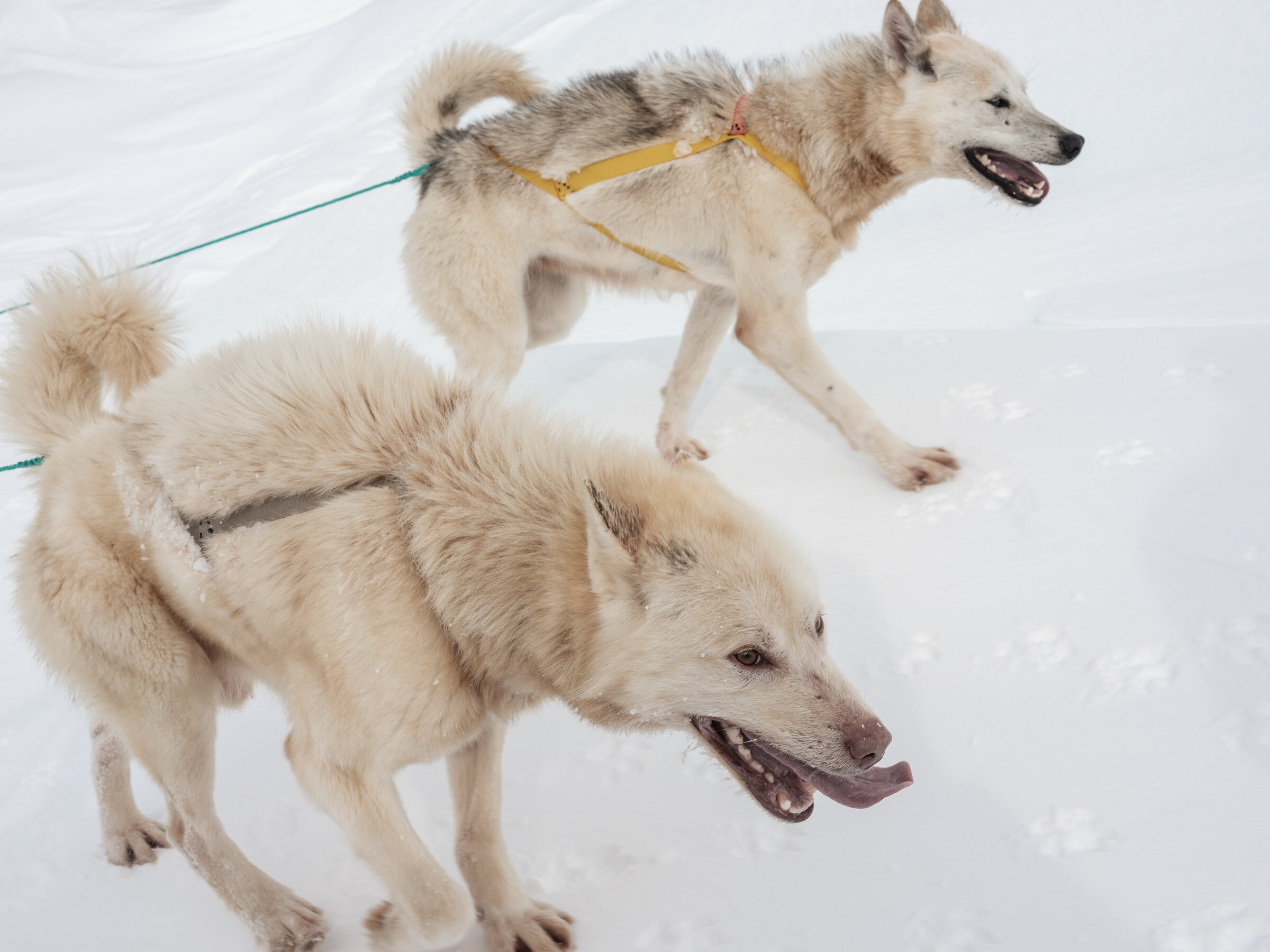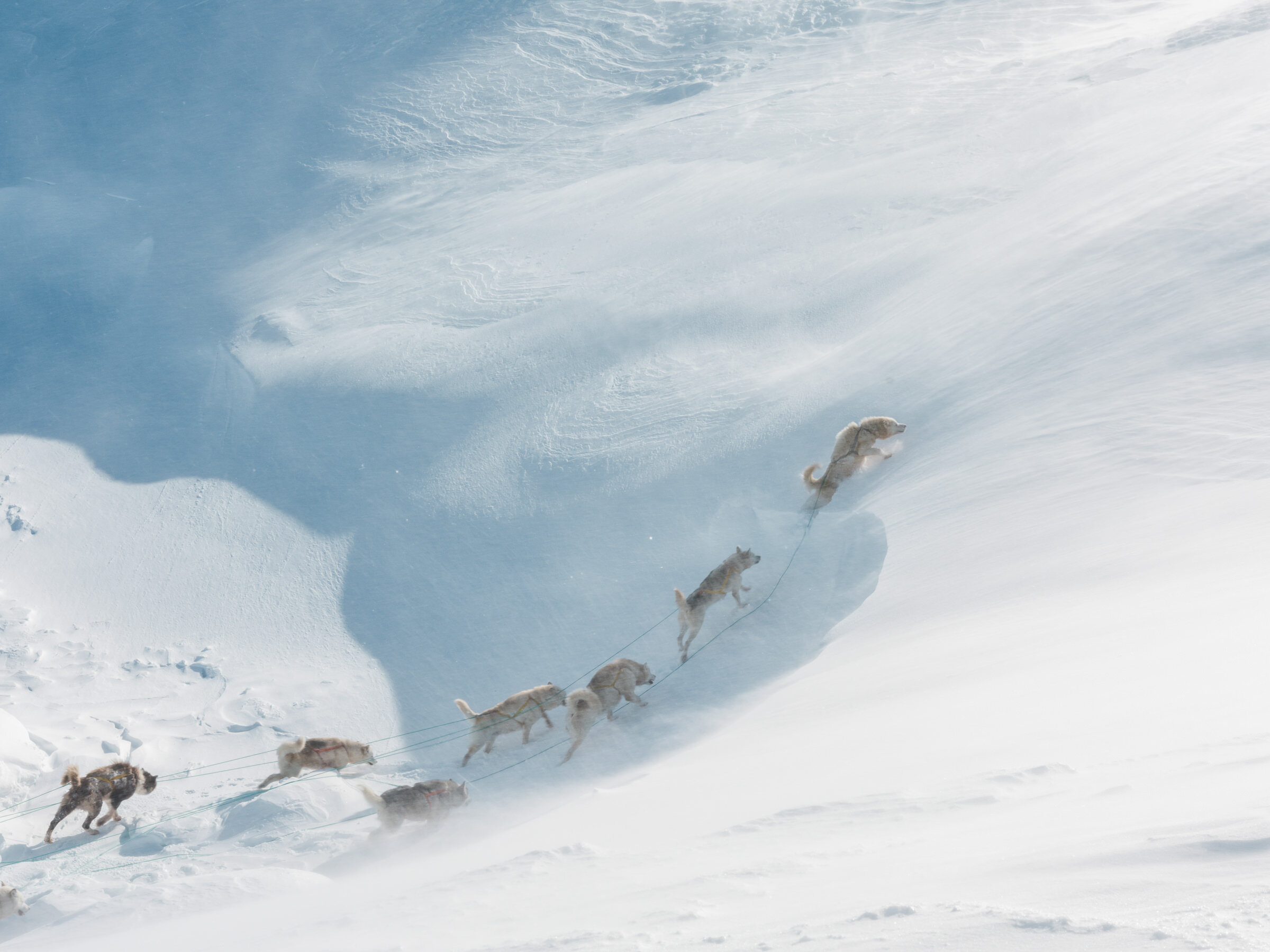Last year was rather depleted in terms of travel for all of us. To compensate, I spent some time with images I took in previous years and decided to put together a couple of photo-narratives on my past travels with the first one here on dog sledding in East Greenland. Growing up in cold snowy winters I do love travelling and photographing in the Arctic and getting back to the North is always a bit of a homecoming for me. This was my third time in Greenland after trekking and sailing visits in 2014 and 2017 and as I love dogs and snow it was only a matter of time that I did a dog sledding trip. My first attempt to do so failed in February 2018 due to severe weather. My second attempt had more luck even though our route and plans were changed due to the weather again. The week-long trip around Ammassalik island with its start at Tasiilaq - on the Sermilik coast with sledding to Tiniteqilaaq and back was a wonderful opportunity to once again see the area where I hiked first time in summer, only this time it was in the company of winter magic landscapes and hard working dogs.
Kulusuk - the gateway to East Greenland. Flying by airplane to this small island and switching to helicopter is the only way one can get to Tasiilaq in winter. Whilst there one may spend a few days waiting for the right weather, that is for low winds and clear sky. The waiting was made easier by synchronised dog howling.
and some wonderfull northern lights shows to brighten up long nights. gfx50r + 63 f2.8
Finally we made it to Tasiilaq, a beautiful location framed by granite peaks. A few fishermen on ice, on the low right side, show the scale.
Winterland… three shots stiched pano, GFX50s + 100/200 f5.6. Two ravens in flight on the right side, but the true scale is shown by fishermen on ice on the low right side. gfx50s + gf100/200 f5.6
Dog station, Tasiilaq
Greenlandic perspective
And we are off, with Egon Poulsen, the best (perhaps the only) Chelsea FC fan in Greenland :)
highway heading North… gfx50r + gf63 f2.8
Colours of Arctic
Resting lines and drinking (eating) snow on a run below
The originally planned route was a five-days circuit around mountains of Ammassalik island. We managed to get only a quarter of our way into it when the weather turned foul and a strong wind called Piteraq that originates on Greenland's ice cap stopped us from going further. Temperatures dropped to low -20s Celsius and the wind speed reached over 100 km/h. So, we decided to stay at the camp at Sermilik fjord in a decent shelter and wait. Whilst we were waiting for the weather to improve another dog sled team joined us. The moment I saw the team approaching I grabbed my GFX50s camera with a long lens (GF100-200 f5.6) and ran outside. I managed to get to the nearest high point, where I was knee-deep in snow, under a barrage of wind, which was blowing ice into my face and my lens.
blizzard gfx50s + gf100/200 f5.6
Raw power, dog team charging up a snow ledge, with a sequence of shots below. gfx50s + 100/200 f5.6
I saw the team approaching a snow ledge where the dogs would have to charge upwards and I started taking shots. The dogs stretched into a great line that was so organic in the immediate landscape and the lead dog powered his way up, so I was very happy despite all the Piteraq gusts and cold. Typically a sled team in Greenland has a fan formation unlike the line setup in Alaska or Siberia, which helps to sled on frozen sea surfaces, so seeing Greenlandic dogs in one nice line is not common.
Leadership… gfx50s + gf100/200 f5.6
Sunset colours. gfx50s + gf100/200 f5.6
Whiteout, Egon Poulsen and his dogs, gfx50s + gf100/200 f5.6
At some point in our trip we got over a ridge and this amazing view opened up with a frozen small plateau and path through the mountains all lit by a low sunset. By that time, we were probably 3-4 hours on a road and my hands and my cameras started to freeze (it was about -25C or lower plus strong wind) but the scenery was so moving that I just had to stand up on the sled, which at that point started to move fast downhill, with one hand on the sled and one with camera trying to grab a couple of shots - see below.
Sunset valley, gfx50r + gf63 f2.8
Sunset valley, gfx50r + gf63 f2.8
Way back to base at Tasiilaq. Below - turning left in wet snow takes extra effort gfx50s + gf63 f2.8
We have lift off… sometimes all paws are up in the air :) gfx50s + gf63 f2.8
Dog sled technology has its origin in Thule culture, which dates to 2,000 to 3,000 years ago. Dog sleds were further refined by the Inuit for travelling and hunting on the frozen waters and fjords in Greenland. The ones in the east are different from the ones in the west, because of the more mountainous terrain, compared to the flatness in the west. It is truly the perfect way to travel in Greenland. The Greenland Dogs were originally brought from Siberia to North America by the Thule people about 1,000 years ago, whilst the first sled dogs can be genetically traced back to 9,500 years in the Siberian Arctic. Greenland dogs are fully adapted to life in the Arctic, they have specific genes to cope with a high fat intake, as do humans and bears who live in the Arctic. They also have a genetic set up that allows them to cope with low oxygen conditions, which presumably contributes to fitness for the extreme demands of long sled-hauling trips. With daily average runs of 60-80km at 9-10km/h speed in freezing environments, across mixed terrain, they definitly need that.
Loved how the dog’s colour matched the colours of granite rocks
The path had a number of frozen lakes, such as the one above. gfx50s + gf63 f2.8
Down the hil in the fast lane… gfx50r + gf63 f2.8
Arctic express - Julius Nielsen and his dogs
Into the white - Julius Nielsen and his dogs gfx50s + gf63 f2.8
Having a break, gfx50r + 100/200 f5.6
Julius Nielsen and his dogs gfx50s + gf63 f2.8
Egon Poulsen with his dogs. gfx50s + gf63 f2.8
Julius Nielsen and his dogs on the way back to Tasiilaq, gfx50s + gf63 f2.8
turning right, gfx50s + gf63 f2.8
Coming home to Tasiilaq, gfx50s + gf63 f2.8
Gear: throughout the trip I used two Fujifilm cameras: GFX50s and GFX50r. One was equipped with a GF63 f2.8 prime (~50mm in FF) and another with a long zoom GF100-200mm f5.6 (~80-160mm in FF). For better ergonomics the GFX50s had a metal grip extension plate (Peipro, part of L-plate) and the GFX50r had LensMate XP2 thumb rest. Both cameras performed as Fujifilm cameras always do - flawlessly. Despite being used at very low temperatures, as low as -25-30C, under heavy wind and snow blasts I did not have any problems with their work and focusing. On one day, the battery in my GFX50r lasted for about 5 hours of use in bitter cold (lower than -20C) and I did not need to replace it. In fact changing it would have been tricky, as my hands were rather frozen by then. The 100-200 f5.6 autofocus locked onto the subject through blizzard’s drifts and the lens being rather light and compact for a medium format system is a wonderful versatile companion for travel where you want to have an extra reach, but do not want to carry a large heavy telephoto. These two bodies and lenses made up a nice compact (for medium format) system, which I kept in a Lowepro 102 slingshot (body+100/200) with a ThinkTank 20 holster (body+63) attached to it. At the end of the day/ride before moving into warmer (even +4C is much warmer than -30C) environment I would place the entire camera “belt” into a large Exped compression dry bag to slowly warm up for an hour or two inside before I would get gear out, if needed. This was necessary to avoid condensation build up due to the fast switch from cold and dry to warm and humid.
Young Greenlander gfx50s + gf100/200 f5.6 @200 f11












